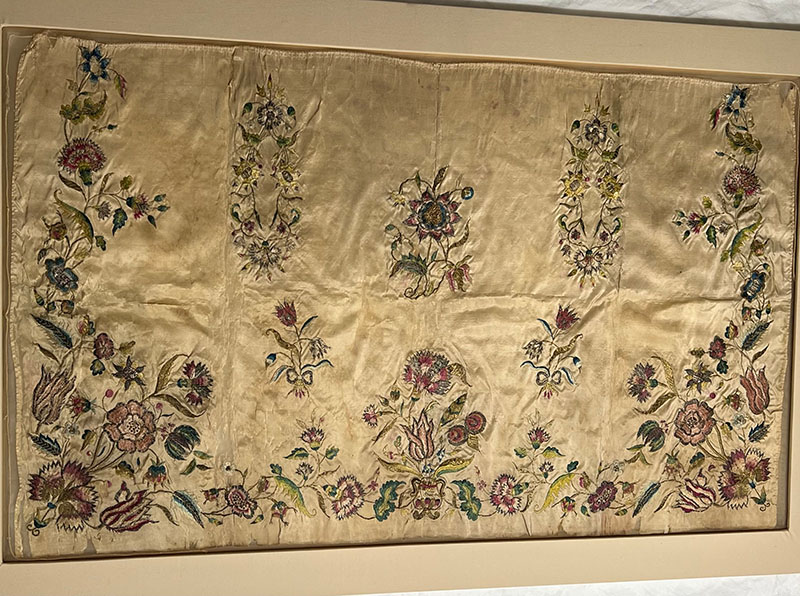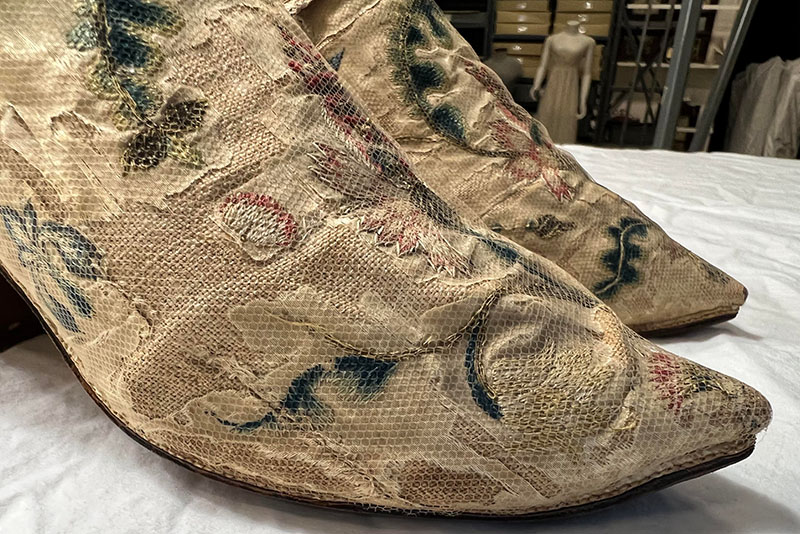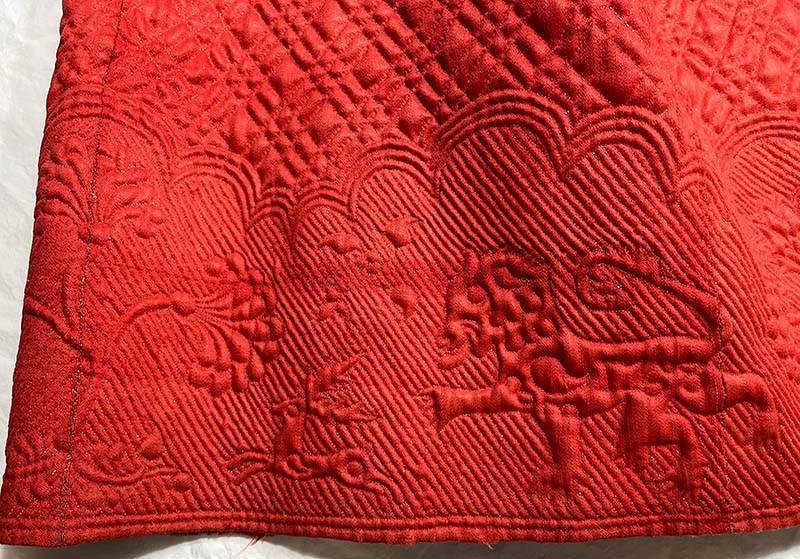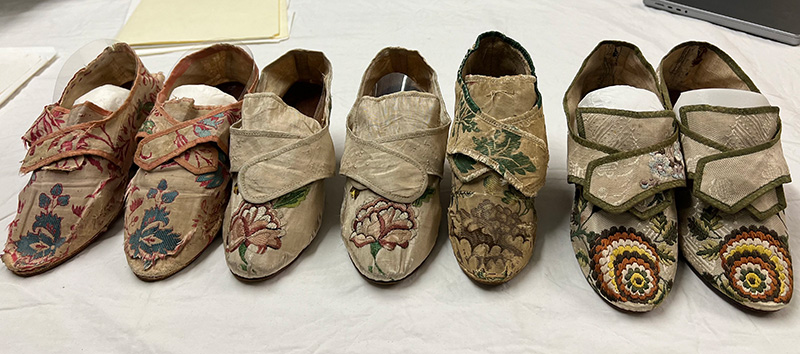Investigating the Materiality of 18th-Century Colonial Embroidered Garments
by Livy Scott
Thanks to the funding provided by a Decorative Arts Trust Research Grant, I had the opportunity to travel to historical societies in Massachusetts and Connecticut to conduct object-focused research for my forthcoming Master’s thesis in Fashion Studies at Parsons School of Design. Titled “(Re)Materializing Eighteenth-Century Embroidered Identities: The Sartorial, Genteel, and Genealogical Lives of Three Colonial Women,” the project brings to life the unexplored sartorial history of this colony, the garments’ original female owners and makers, and the broader colonial fashion system. By focusing on a series of microhistories, object biographies will offer new insights into four women’s historically hidden personal history and their sartorial ideologies as revealed through the materiality of the objects’ threads.
Each of my three chapters centers around one garment’s life cycle and owner. The practice of close looking is central to this investigation. By emphasizing the details of construction or wear on a garment, this approach enabled me to discover small holes, stains, stitches, or thread types that held much larger significance. The success of this method depended upon seeing these objects in person.
I first traveled to the Connecticut Historical Society in Hartford to study three of my four research subjects. Observing an apron potentially embroidered by either Mary Hooker Pierpont, Mary Pierpont Russell, or Mary Russell Talcott (figure 1) enabled me to identify a series of small selvage holes in the white silk taffeta grounding that are consistent with those typically produced by 18th-century Chinese looms. I discussed this object in a lecture during the Decorative Arts Trust’s Emerging Scholars Colloquium in January 2023. The expensive gold thread on the embroidered shoes of Hannah Edwards Wetmore (figure 2) raised interesting questions about where and how often she intended to wear these shoes. Closely studying Sarah Halsey’s handmade quilted petticoat (figure 3) helped me identify each animal motif on the border of the design and her potential sources of inspiration.
Figure 1. Possibly Mary Hooker Pierpont, Mary Pierpont Russell, or Mary Russell Talcott, Hooker/Pierpont/Russell/Talcott Family Apron, 1730–40, Connecticut. Silk and metallic thread, plain-weave cream silk. Connecticut Historical Society, 1859.9.0.
Figure 2. Attributed to Hannah Edwards Wetmore and Mary (Molly) Edwards, Wedding shoes, 1745–46, probably East (now South) Windsor, CT. Hand-stitched and embroidered silk, metallic threads on silk and linen, leather, wood. Connecticut Historical Society, 1840.7.1a,b.
Following the chance to view some additional pieces of crewelwork embroidery and shoes, I dove into the CHS’s archival manuscript collection to discover more about the Pierpont/Russell/Talcott families, the Edwards family, the Halsey family, and the Wadsworth families, respectively. I reviewed numerous related account books, diaries, and letters, searching for details that could illustrate the families’ consumption patterns or views on religion, fashion, and kinship ties. The most fruitful of these sources was Samuel Talcott’s letter to his future wife, Abigail Ledyard, in 1767 (figure 4). Talcott details the virtues and manners that make a good lady, essentially outlining his views on the construction and importance of gentility and, as he phrases it, “good breeding” across multiple generations.
I continued my research at Historic Deerfield (figure 5), where I was able to immerse myself in the rich colonial Connecticut River Valley culture. My thesis agrees with scholars like Kevin Sweeney that this area in Massachusetts and Connecticut has a distinct regional character, and the colonial elites had their own specific techniques to establish hierarchy and to materially emphasize their gentility. My thesis stresses that this trend is also discerned in the region’s fashion and embroidery.
Finally, I traveled to Haverhill to visit the headquarters of Historic New England. Their extensive collection contained a number of garments I studied as potential objects to compare to my main thesis subjects. For example, seeing shoes from the 1740s to the 1770s (figure 6) allowed me to analyze differences in construction between imported shoes from London and Hannah’s domestic pair. It also offered insights into the stylistic shifts over the decades, such as the move from the needlepoint toe to the later, more rounded blunt toe.
Overall, these research trips enabled a successful object analysis of critical primary sources that define my thesis. As a result of the study of these surviving extant garments and archival records, this research will produce embodied and individualistic (yet interconnected) microhistories centered around object biographies, personal autobiographies, and genealogical webs from early-to-mid-18th-century Connecticut. I am deeply grateful to the Decorative Arts Trust for supporting my object-focused research into colonial fashion history.
Olivia “Livy” Scott recently graduated from the Fashion Studies program at Parsons School of Design.
About The Decorative Arts Trust Bulletin
Formerly known as the "blog,” the Bulletin features new research and scholarship, travelogues, book reviews, and museum and gallery exhibitions. The Bulletin complements The Magazine of the Decorative Arts Trust, our biannual members publication.
Click Images to Enlarge
Did you know that clicking on the images in Bulletin posts will allow you to get a closer look? Simply click on an image, and a larger version will open in a pop-up window.













